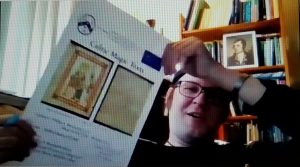Phillip A. Bernhardt–House
(Skagit Valley College, Whidby Island Campus,
and Columbia College, NAS Whidby Island Campus)
(Auto)Biography, Anonymity, and Authority:
Prologues and Their Lack in a Selection of Magical Texts
(A Response)

Hermes Trismegistus. Frontispiece image (Lyons, 1669) via Wikimedia Commons and Wellcome Images.
Abstract of Response
To be presented at the 56th International Congress on Medieval Studies
(Kalamazoo, 2021)
Session on “Prologues in Medieval Texts of Magic, Astrology, and Prophecy”
Organized by Vajra Regan
Co-Sponsored by the RGME and the Societas Magica (for the 2021 Congress)
(Session Rescheduled from the cancelled 2020 Congress, and partly Rearranged for the 2021 Congress)
2021 Congress Program Planning
*****
Abstract
A “prologue” is another term for what in English is often called a ‘foreword’ in any written work, and can provide many details about the work. These details are often presented in the exegetical formula of tempus, locus, persona, and causa scribendi, but not exclusively nor exhaustively.
In two cases discussed in this Session, we have directly-identified famous historical or perhaps pseudo-historical magicians to whom magical texts are attributed.
- One is Astrampsychos/Astrapsouchos, purportedly a Persian of the time of Alexander the Great, to whom several magical texts including lapidaries and dream books are ascribed, along with a spell in the Papyri Graecae Magicae corpus (PGM), as well as a popular sortilege text which has a short prologue.
- Another is Pachrates/Pancrates of Heliopolis, an Egyptian magician, priest, and poet of the early second century CE. He gave a spell in the PGM corpus to the Emperor Hadrian in circa 130 CE, and wrote an epic poem now extant only in fragments about a lion hunt that Hadrian and his deified favorite Antinous performed. Pachrates also became a literary character in the Philopseudes by Lukian of Samosata in the later second century, and, through this source, has entered posterity as the first literary example of the titular “sorcerer” in the folktale of the “Sorcerer’s Apprentice” popularized by Disney’s Fantasia.
In these cases, are the attributions in these prologues pseudepigraphical or biographical? Or perhaps do they function more along the lines of historiolae that give the magical practices detailed an added efficacy due to their connection with famous magicians who interacted with well-known rulers?
However, some other magical texts have more instructional details or procedural advice and requirements in their prologues, but give no indication of authors or other aspects of the exegetical formula.
In the case of the early-medieval Irish St. Gall Incantations, surviving in a single manuscript, there are no attributions of the spells to anyone in particular, whether historical or fictional. This is especially odd, because in medieval Irish manuscripts, poetry is often given an attribution, whereas prose rarely if ever is. As the spells in the St. Gall manuscript (Saint Gall, Stiftsbibliothek, Codex 1395, page 419) often have poetic qualities or forms, this reticence is noteworthy indeed. Not even a mythological personage is mentioned in these texts as the originator of the magical operations, though the spells themselves refer to both Christian and non-Christian supernatural beings. Thus, does this lack and this anonymity serve to highlight the potentially illicit nature of the texts concerned?
By casting one’s net widely and diversely, and juxtaposing these examples with those discussed by the panelists in this session, it is hoped that the purposes of prologues as essential parts of the magical operations themselves can be probed. Such exploration might address the nature of the lapidary text examined by Vajra Regan, and might illuminate how mythological anonymity in relation to magic can serve to distance an author, scribe, and even audience from the negative connotations of magical texts and their contents in the case of the Picatrix, as discussed by David Porreca.
*****
Note:
For the other Abstracts for this Session, see
The “Saint Gall Incantations” survive in one manuscript source now at Saint Gall in Switzerland (shown via www.e-codices.unifr.ch/, specifically at page 419 in a composite volume). Their texts stand on the originally blank verso of a single despoiled leaf. The recto carries an illustration of the Evangelist Matthew as a scribal author. The verso contains the text of the charms in Old Irish, entered presumably within an available space in the original manuscript.

Saint Gall, Stiftsbibliothek, Codex Sang. 1395, page 418, via www.e-codices.ch.

Saint Gall, Stiftsbibliothek, Codex Sang. 1395, page 419, via www.e-codices.ch.

At the 2021 Congress online, Phillip Bernhardt-House shows the RGME Poster for his 2018 Congress Session.
A Session organized by Phillip and co-sponsored by the Research Group on Manuscript Evidence and the Societas Magica included an examination of these text. See our 2018 Congress and Slavin 2018 Congress.
On the day of his Response, Phillip held up onto the online Screen a copy of the Poster for that 2018 Session.
*****
We thank Phillip for his contributions to our Sessions over the years, as Organizer, as Presenter, and as Respondent. For example:
- Bernhardt-House (2018 Congress).
- Bernhardt-House (2008 Congress).
- Bernhardt-House (2021 Congress). You are Here.
*****
